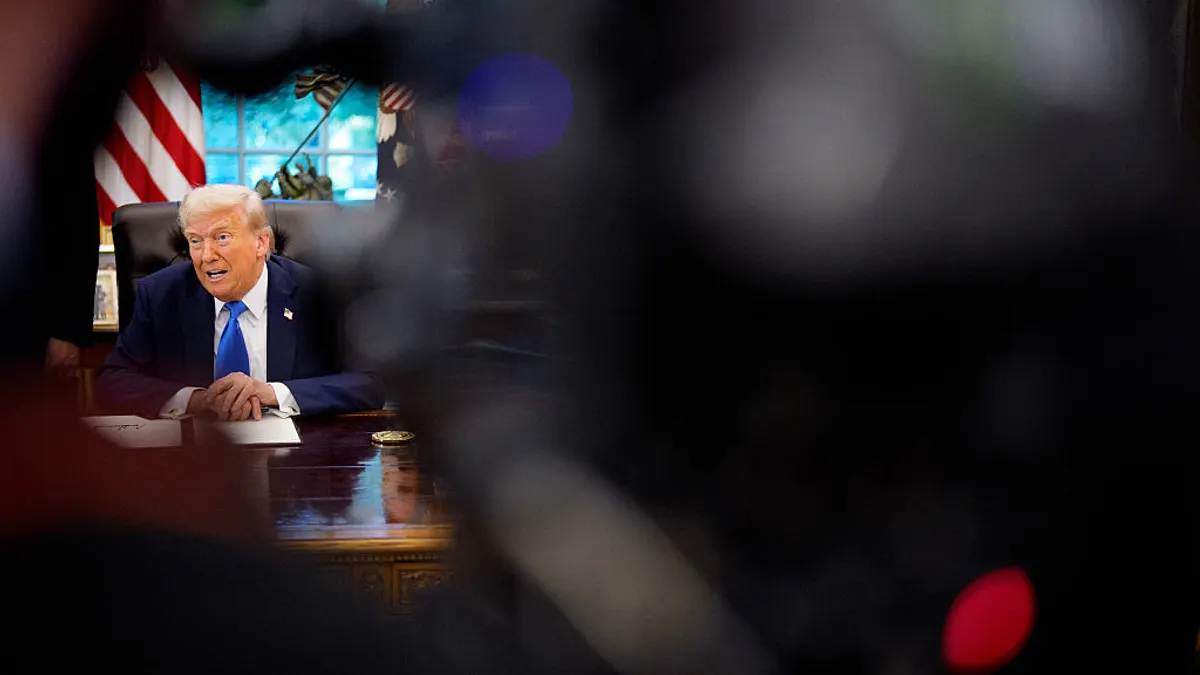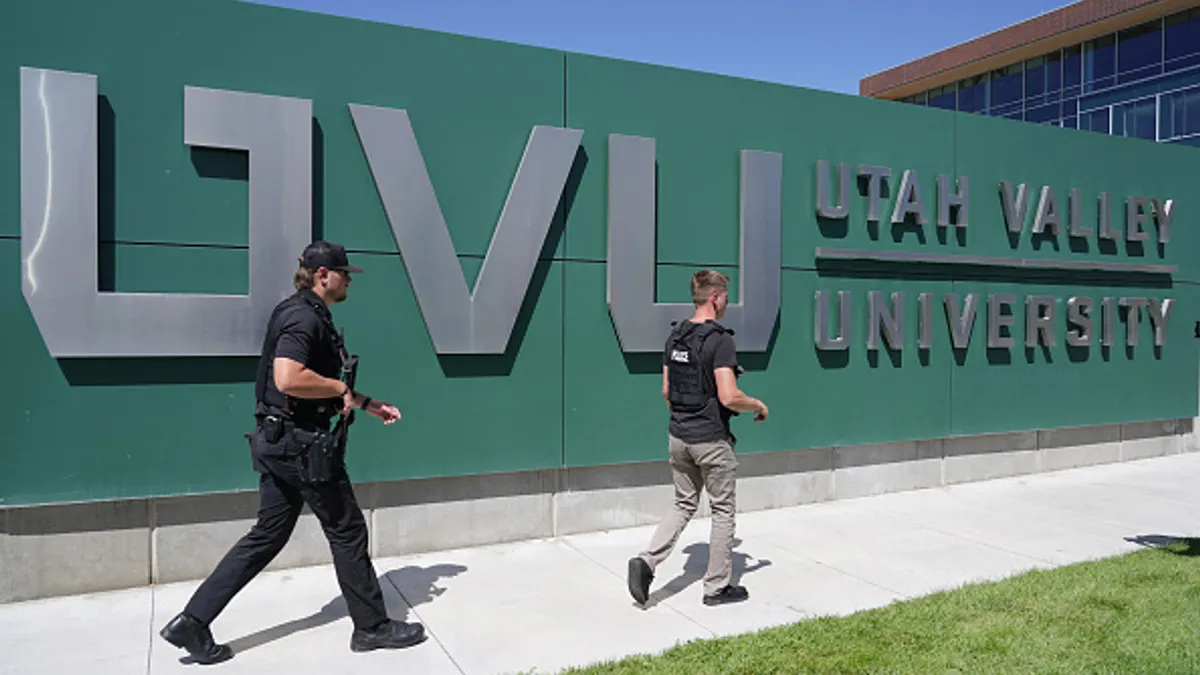The scene opens like a college recruitment film — a sunny day on campus with students quietly chatting and studying on a lawn, along a lake and in a library. But the background music shifts and there are hints in the chatter that there might be trouble. An agitated young man steps from a car, pulls out a gun and trudges through campus, shooting wildly while students scream and run in all directions.
Suddenly, a frightened young woman is speaking into the camera. Students run past her as gunshots echo down the covered outdoor corridor where she is hiding. "If you hear gunshots, don't wait until others tell you to act," she warns, wide-eyed and breathless. "If it's safe to run, run." As the shooter turns the corner and comes into view, she scrambles away.
That's just the beginning of a five-minute "run, hide, fight" lesson played out in a realistic new video from Northwestern University that instructs students how to behave in an active shooter situation. And it represents a shift in how colleges are engaging their students on the topic of campus safety at a time when gun violence is a growing concern.
The new reality
That video will be played to all new Northwestern students, faculty and staff next fall, driving home the gravity of the issue of shootings on college campuses — a concern born a decade ago when 32 students and faculty members were killed by a shooter at Virginia Tech. It has been vividly reinforced, however, through the spate of shootings since that have affected higher education, including those at Northern Illinois University in 2008, at Oregon's Umpqua Community College in 2015 and earlier this month at a Thousand Oaks, California, bar where college students were packed in for a special event.
The number of shooting incidents on or near college campuses is on the rise, doubling from the 2011-12 academic year to the 2015-16 academic year when 101 incidents were recorded, according to a 2016 report based on a nationwide survey from the Citizens Crime Commission of New York City. The figure is up 153% from the 2001-02 to 2005-06 period.
These incidents have also become more catastrophic, with 208 casualties from 2011-12 to 2015-16, a 241% increase from the 2001-02 to 2005-06 period. In all, there were 190 campus shooting incidents from 2001-02 to 2015-16, in which 437 people were shot with 270 wounded and 167 killed, the report found.
Their prevalence is spurring colleges to do more to prepare their students. Northwestern's video is one example of efforts they and other campuses are taking on three fronts: enhancing security systems, improving mental health care and making it easier for students to report concerns, and informing students what to do in the event of an active shooter.
"We were a little concerned about the intensity of this film and the way it depicted a shooting so realistically, but we felt we needed to drive these points home," said Greg Klaiber, director of emergency management at Northwestern. "It is the world we live in."
Tactics for reducing risk
The film is a more dramatic version of the type used on many campuses, and it is among the tools colleges are adding today to raise awareness and aid prevention on campus. Those tools can be both high and low tech.
On the tech side, they include emergency phones with 360-degree security cameras, loudspeakers to announce a threat, multiple-platform communication systems to alert the entire campus quickly and more security entry systems installed on buildings.
A security consultant recommended, for instance, that Northwestern improve its communications system. Soon students, faculty and staff members may more quickly get text messages, tweets and emails about an event or emergency, as will visitors to campus and parents if they wish. The alerts will be visible on new displays throughout campus and on other existing screens.
The University of Nevada Las Vegas is spending $16.5 million to upgrade its campus security infrastructure, which will include emergency call stations, Campus Safety reported. The move to invest more in security came months after a gunman killed 58 people and wounded hundreds more from his room in a hotel overlooking a concert venue on the Las Vegas Strip near campus.
"We were a little concerned about the intensity of this film and the way it depicted a shooting so realistically, but we felt we needed to drive these points home. It is the world we live in."

Greg Klaiber
Director of emergency management, Northwestern University
Meanwhile, lower-tech tools can include more and better trained campus police.
Campus security personnel are now trained to gravitate to groups of students, check out suspicious activity more aggressively and fully resolve a disturbance or a concern about a person, according to campus security expert Brian Van Brunt. They are now also trained to pursue the attacker immediately during an event rather than secure the area and proceed methodically. The new strategy is prompted by the prevalence of guns that are capable of quickly killing many.
Space-wise, college campuses are generally open, with students, faculty, staff and visitors frequently traveling through unenclosed areas or attending large gatherings, said Pete Anders, police chief at Millersville University, a public college in Pennsylvania. That makes them harder to secure.
"Public colleges often have acres of land and multiple buildings. MU, with 8,000 students, has 250 acres and more than 100 buildings. It's impossible to lock it down entirely," he said.
In response, Millersville expanded its information and alert systems and provided extensive training for its security team through a nationally recognized ALERRT active shooter response training program sponsored by the Advanced Law Enforcement Rapid Response Training Center at Texas State University.
Being prepared
One of the biggest changes colleges can make to protect their campus community from gun and other violence is to develop their own behavioral intervention teams (BIT) made up of representatives from counseling, administration, security and other campus groups, says Brett Sokolow, president and CEO of The NCHERM Group, which consults with colleges and universities on campus safety issues. He said between 30% and 40% of colleges employ this method.
Northwestern's multidisciplinary Behavorial Consultation Team meets weekly to review what Klaiber said is typically about three referrals regarding concerns on campus. They range from reports of students who seem depressed or angry to concerns about being threatened. The team determines which college service will follow up. It has representatives from departments across the university, including campus police, the Dean of Students office, human resources, legal, the Office of Equity, Counseling and Psychological Services (CAPS), and the Office of the Provost.
Virginia Tech quickly developed such a team following the mass shooting on its campus in 2007, said Mark Owczarski, assistant vice president of university relations. Like those at Millersville and Northwestern, it includes representatives from various campus departments.
"Campus police have done dozens of other things to keep our campus safer, but empowering our students and others to report is so very important," he said.
Most colleges have some form of BIT team, Van Brunt noted, though their thoroughness may vary.
Van Brunt is the executive director of the National Behavioral Intervention Team Association, which in August released new standards and guidance for these teams that empower them to look into concerns with a clear rubric and understanding of what circumstances and behaviors are most threatening.
"Campus police have done dozens of other things to keep our campus safer, but empowering our students and others to report is so very important."

Mark Owczarski
Assistant vice president of university relations, Virginia Tech
Threat assessment teams are a goal of a Call for Action shared two weeks after the shooting at Marjory Stoneman Douglas High School last winter. The document gained national attention and endorsements from more than 2,300 experts in the field and 200 colleges and universities, school districts, and education and mental health groups.
Matthew Mayer, an associate professor at the Rutgers Graduate School of Education and one of two professors who initiated the effort, believes that while schools must prioritize security, prevention efforts comes with an awareness about vulnerable students.
"Following school shootings, there is a tendency to focus heavily on security measures such as metal detectors, cameras and armed guards," he said. "They make politicians and school administrators appear as if they are doing something meaningful, but while school security is very important, they have only limited benefits, and often, they displace the much more needed work."
The culture factor
Schools are safer when they cultivate social and emotional health and respond to troubled students quickly, said Ron Avi Astor, a key player in Mayer’s Call for Action and a professor of behavioral health at the University of Southern California. That environment helps students experiencing mental health issues feel more comfortable addressing them with another student, a professor or a counselor, and makes members of the campus community more willing to give assistance.
"Working on the culture in our schools, how we treat each other and look out for each other and the services we offer will pay off, although it is less-visible, harder work that needs to happen every day over years," he said.
Additionally, mental health counselors must be better trained to identify and help students who could pose a threat to campus or themselves, Van Brunt said.
"Working on the culture in our schools, how we treat each other and look out for each other and the services we offer will pay off, although it is less-visible, harder work that needs to happen every day over years."

Ron Avi Astor
Professor of behavioral health, University of Southern California
It's a common misconception that such attacks are carried out by students with frequently diagnosed mental health issues such as depression or schizophrenia, he noted. However, specific issues such as a past trauma or a history of suicidal thoughts can also be causes and may require specialized training to identify and treat.
This all helps with the overarching message repeated on campuses today: "See something, say something." It is a component of the dramatic Northwestern video and has been used repeatedly at Virginia Tech.
"We inform and educate students from new student orientation to graduation about campus safety, about how to care for themselves and others, and how to inform authorities when needed, which is so critical," says Virginia Tech's Owczarski. "We do this in scores and scores of ways and it is simply part of our campus culture, and it is a never-ending effort."














